Bleipriester
Freedom!
Only seconds from Europe´s first mars landing, the lander messed up and the ESA lost the connection to Schiaparelli. The reason is still unclear. It might be typical European failure.

Europe Lost Contact with Mars Lander 1 Minute Before Touchdown
Another great example for the ESA "plagiarism" and failure is the new VEGA rocket, a small European rocket capable of transporting multiple payloads. The ESA boasted of this ability but what they don´t tell you is that the upper stage is actually Russian. Of course, you won´t find the Russian flag on the rocket.
"Avio and the Italian Space Agency would prefer that the vehicle’s enhancements include the German government’s entry into Vega through the use of a German-built Vega upper stage. The German Aerospace Center, DLR, has said it is open to joining the program."
Vega Builders See Opportunity in Rising Russian Rocket Prices - SpaceNews.com

Europe Lost Contact with Mars Lander 1 Minute Before Touchdown
Another great example for the ESA "plagiarism" and failure is the new VEGA rocket, a small European rocket capable of transporting multiple payloads. The ESA boasted of this ability but what they don´t tell you is that the upper stage is actually Russian. Of course, you won´t find the Russian flag on the rocket.
"Avio and the Italian Space Agency would prefer that the vehicle’s enhancements include the German government’s entry into Vega through the use of a German-built Vega upper stage. The German Aerospace Center, DLR, has said it is open to joining the program."
Vega Builders See Opportunity in Rising Russian Rocket Prices - SpaceNews.com
